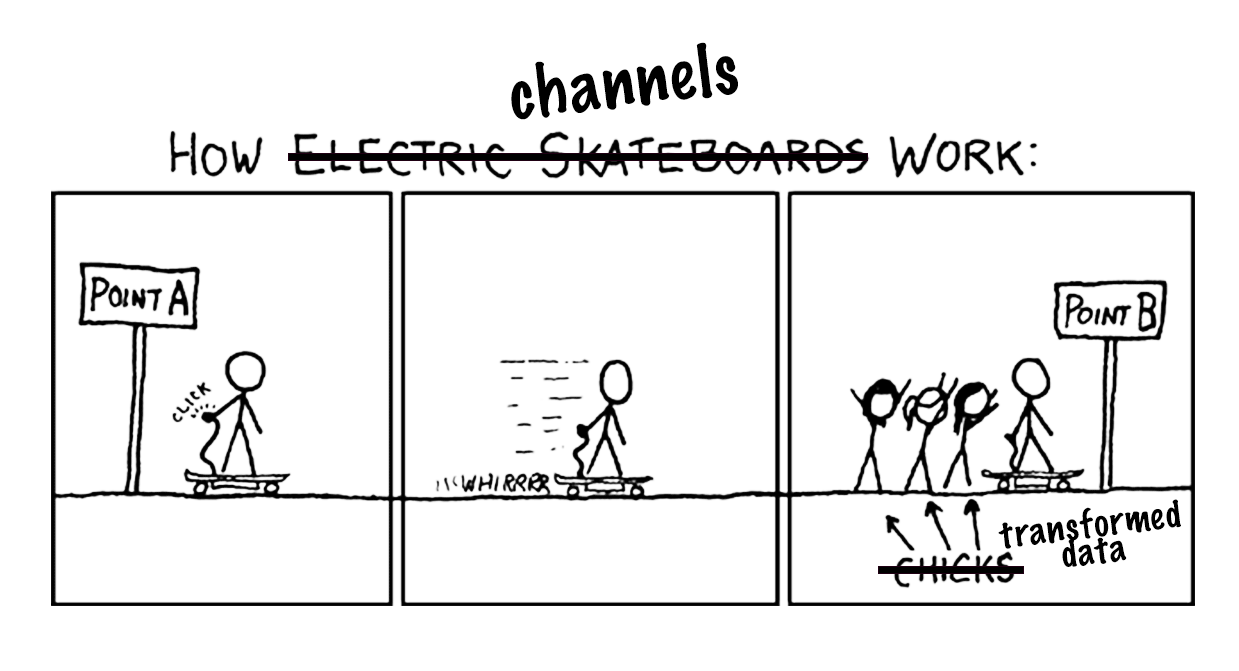
Security News
Deno 2.2 Improves Dependency Management and Expands Node.js Compatibility
Deno 2.2 enhances Node.js compatibility, improves dependency management, adds OpenTelemetry support, and expands linting and task automation for developers.
component-channel
Advanced tools
Event comes in here, event comes out there.

A channel is a two-sided event emitter with support for middleware. If you emit an event on the a side it will come out on the b side, and vice versa.
var chan = channel();
chan.b.on('foo', function(thing) { console.log(thing) });
chan.a.emit('foo', 'thing');
Outputs:
thing
Channels can operate on the data being transmitted through express-like middleware.
var chan = channel();
// uppercase middleware
chan.use(function(evt, next) {
evt.args = evt.args.map(function(str) { return str.toUpperCase() });
next();
});
chan.b.on('foo', function(thing) { console.log(thing) });
chan.a.emit('foo', 'thing');
Outputs:
THING
Middleware are executed asynchronously, so you can do interesting things like introducing latency or dropping events to simulate adverse network conditions locally.

evt middleware parameterevt contains the following properties:
source: the source endpoint. you can check if the event came from a or b, by comparing this value with this.a and this.b inside the middleware.name: the event nameargs: the event argsnext middleware parameterJust call next() to propagate the event to the next middleware in the chain, or to emit the event if you're the last middleware.
To drop an event, simply return without calling next().
Here are some applications of channel middleware:
You can use the pipeIn() and pipeOut() methods in the a and b endpoints to easily connect channels to event emitters, other channels or to something like socket.io.
This is useful, for example, for fanning in events from multiple sources into a single event emitter.
The pipe() method is also available when you want to simultaneously pipe events in and out.
Install with component(1):
$ component install component/channel
channel()Creates a new Channel.
Channel#aThe a Endpoint of the channel.
Channel#bThe b Endpoint of the channel.
Channel#use(middleware)Use a middleware on this channel. middleware is a function, taking two parameters: evt and next.
Endpoint#emit(name, args...)Emit an event with name and args. (It will fire on the other Endpoint, after going through the middleware);
Endpoint#on(name, fn)Register fn as a handler function for event name.
Endpoint#pipeOut(name, target)Pipe out name events into target. Target can be an Emitter, another Channel or anything that exposes an emit() method.
Endpoint#pipeIn(name, target)Pipe in name events from target. Target can be an Emitter, another Channel or anything that exposes an on() method.
Endpoint#pipe(name, target)Equivalent to calling both pipeOut() and pipeIn().
The MIT License (MIT)
Copyright (c) 2014 Automattic, Inc.
Permission is hereby granted, free of charge, to any person obtaining a copy of this software and associated documentation files (the "Software"), to deal in the Software without restriction, including without limitation the rights to use, copy, modify, merge, publish, distribute, sublicense, and/or sell copies of the Software, and to permit persons to whom the Software is furnished to do so, subject to the following conditions:
The above copyright notice and this permission notice shall be included in all copies or substantial portions of the Software.
THE SOFTWARE IS PROVIDED "AS IS", WITHOUT WARRANTY OF ANY KIND, EXPRESS OR IMPLIED, INCLUDING BUT NOT LIMITED TO THE WARRANTIES OF MERCHANTABILITY, FITNESS FOR A PARTICULAR PURPOSE AND NONINFRINGEMENT. IN NO EVENT SHALL THE AUTHORS OR COPYRIGHT HOLDERS BE LIABLE FOR ANY CLAIM, DAMAGES OR OTHER LIABILITY, WHETHER IN AN ACTION OF CONTRACT, TORT OR OTHERWISE, ARISING FROM, OUT OF OR IN CONNECTION WITH THE SOFTWARE OR THE USE OR OTHER DEALINGS IN THE SOFTWARE.
FAQs
two sided event emitter with middleware
We found that component-channel demonstrated a not healthy version release cadence and project activity because the last version was released a year ago. It has 1 open source maintainer collaborating on the project.
Did you know?

Socket for GitHub automatically highlights issues in each pull request and monitors the health of all your open source dependencies. Discover the contents of your packages and block harmful activity before you install or update your dependencies.

Security News
Deno 2.2 enhances Node.js compatibility, improves dependency management, adds OpenTelemetry support, and expands linting and task automation for developers.

Security News
React's CRA deprecation announcement sparked community criticism over framework recommendations, leading to quick updates acknowledging build tools like Vite as valid alternatives.

Security News
Ransomware payment rates hit an all-time low in 2024 as law enforcement crackdowns, stronger defenses, and shifting policies make attacks riskier and less profitable.